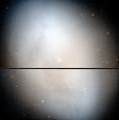NGC 1360
Appearance
| Nebula | |
|---|---|
 NGC 1360 | |
| Observation data: J2000 epoch | |
| Right ascension | 03h 33m 14.646s[1] |
| Declination | −25° 52′ 18.214″[1] |
| Distance | 1,145 ly (351 pc)[1] 1,794 ly (550 pc)[2] ly |
| Apparent magnitude (V) | 9.4[3] |
| Apparent dimensions (V) | 11.0 × 7.5 arcmin[3] |
| Constellation | Fornax |
| Notable features | 11.4v magnitude central star[3] |
| Designations | PK220-53.1, ESO 482-PN007, AM 0331-260, GC 5315, PN G220.3-53.9, CD-26 1339 |
NGC 1360, also known as the Robin's Egg Nebula,[4] is a planetary nebula in the constellation of Fornax. It was identified as a planetary nebula due to its strong radiation in the OIII (oxygen) bands. Reddish matter, believed to have been ejected from the original star before its final collapse, is visible in images.[5] It is slightly fainter than IC 2003.
NGC 1360 was discovered in January 1868 by the German astronomer Friedrich August Theodor Winnecke.[6]
Gallery
-
Hubble Space Telescope image
References
- ^ a b c "SIMBAD Astronomical Database". Results for NGC 1360. Retrieved 2011-06-03.
- ^ Smith, H. (9 April 2015). "On the distances of planetary nebulae" (PDF). Monthly Notices of the Royal Astronomical Society. 449 (3): 2980–3005. arXiv:1409.3422. Bibcode:2015MNRAS.449.2980S. doi:10.1093/mnras/stv456.
{{cite journal}}: CS1 maint: unflagged free DOI (link) - ^ a b c "NGC/IC Project". Results for IC 1295. Retrieved 2011-06-03.
- ^ http://www.myastrostuff.com/pncollection/ngc1360.htm
- ^ http://www.astrosurf.com/antilhue/ngc1360.htm Astrosurf
- ^
Students for the Exploration and Development of Space. "Friedrich August Theodor Winnecke (February 5, 1835 - December 3, 1897)". http://seds.org/. Retrieved March 18, 2012.
{{cite web}}: External link in|publisher=
External links
- http://observing.skyhound.com/archives/dec/NGC_1360.html
- NGC 1360 on WikiSky: DSS2, SDSS, GALEX, IRAS, Hydrogen α, X-Ray, Astrophoto, Sky Map, Articles and images

